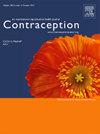Preclinical development of a novel injectable hydrogel for vas-occlusion
IF 2.3
2区 医学
Q1 OBSTETRICS & GYNECOLOGY
引用次数: 0
Abstract
Objectives
The objective of this work is to outline the preclinical development of ADAM, an injectable, two-component polyethylene glycol hydrogel designed for long-lasting and nonpermanent vas-occlusive contraception.
Study design
A newly developed hydrogel was comprehensively characterized to evaluate its potential as a male contraceptive device. The material was optimized for porosity to ensure sperm occlusion, rheological properties, injectability, and mechanical durability within the dynamic vessel. Biocompatibility of the hydrogel was assessed using a suite of ISO 10993 tests, which are critical for clinical translation and supporting a future regulatory submission. The canine model was utilized to assess the chronic tissue response of the vas deferens post implantation, providing insights into long-term safety and functionality.
Results
The vas-occlusive hydrogel demonstrates selective permeability with a pore size of 10 to 20 nm, effectively preventing sperm passage while allowing diffusion of small molecules. Its mechanical properties facilitated injection into the vas deferens with minimal force (3.1 N), forming a viscoelastic material within 30 seconds, with the ability to resist ejaculatory pressures. The implant and its degradation products were found to be noncytotoxic, nonirritating, nonsensitizing, and nongenotoxic. Moreover, a 2-year in vivo study in a canine model showed minimal tissue reaction following implantation, with no adverse effects reported.
Conclusions
These findings indicate that the hydrogel’s chemical and mechanical properties align with the requirements for a safe, effective, and nonpermanent vas-occlusive contraceptive.
Implications
Currently, men lack options for effective, long-lasting, and reversible contraception. The development and evaluation of the study hydrogel described here suggest it would make a safe and effective vas-occlusive contraceptive and should be researched further in a clinical setting.
一种用于血管闭塞的新型注射水凝胶的临床前开发。
目的:本研究的目的是概述ADAM®的临床前开发,ADAM®是一种可注射的双组分PEG水凝胶,设计用于持久和非永久性血管闭塞性避孕。研究设计:对一种新开发的水凝胶进行了全面表征,以评估其作为男性避孕装置的潜力。该材料针对孔隙度进行了优化,以确保精子在动态血管内的闭塞性、流变性、可注射性和机械耐久性。水凝胶的生物相容性使用一套ISO 10993测试进行评估,这对临床转化和支持未来的监管提交至关重要。该犬模型用于评估输精管植入后的慢性组织反应,为长期安全性和功能性提供见解。结果:血管闭塞水凝胶具有选择性通透性,孔径为10 ~ 20 nm,有效阻止精子通过,同时允许小分子扩散。它的机械性能使注射进入输精管的力最小(3.1 N),在30秒内形成粘弹性材料,具有抵抗射精压力的能力。植入物及其降解产物无细胞毒性、无刺激性、无致敏性和无基因毒性。此外,一项为期两年的犬模型体内研究显示,植入后组织反应最小,无不良反应报告。结论:这些研究结果表明,水凝胶的化学和机械性能符合安全、有效和非永久性静脉闭塞避孕药的要求。启示:目前,男性缺乏有效、持久、可逆的避孕方法。本文所述的研究水凝胶的发展和评价表明,它将是一种安全有效的血管闭塞避孕药,应在临床环境中进一步研究。
本文章由计算机程序翻译,如有差异,请以英文原文为准。
求助全文
约1分钟内获得全文
求助全文
来源期刊

Contraception
医学-妇产科学
CiteScore
4.70
自引率
17.20%
发文量
211
审稿时长
69 days
期刊介绍:
Contraception has an open access mirror journal Contraception: X, sharing the same aims and scope, editorial team, submission system and rigorous peer review.
The journal Contraception wishes to advance reproductive health through the rapid publication of the best and most interesting new scholarship regarding contraception and related fields such as abortion. The journal welcomes manuscripts from investigators working in the laboratory, clinical and social sciences, as well as public health and health professions education.
 求助内容:
求助内容: 应助结果提醒方式:
应助结果提醒方式:


